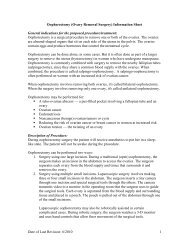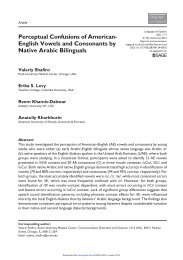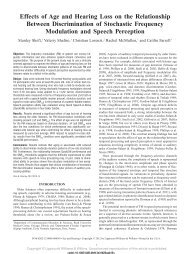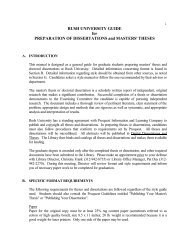Perceptual confusions of American English vowels ... - Rush University
Perceptual confusions of American English vowels ... - Rush University
Perceptual confusions of American English vowels ... - Rush University
You also want an ePaper? Increase the reach of your titles
YUMPU automatically turns print PDFs into web optimized ePapers that Google loves.
and stress are predictors WaldZ 0.02p 0.05. The results suggest that<br />
perceptual cues vary according to L1 and pr<strong>of</strong>iciency level.<br />
6pSWa40. Language background influences the emergence <strong>of</strong> voice<br />
onset time production and perception. Andrea A. N. MacLeod Pavillon<br />
Vandry, Univ. Laval, PQ, QC G1S 3H3, Canada, Susan Rvachew, and<br />
Linda Polka McGill Univ., Montreal, QC H3G 1A8, Canda<br />
This study investigates the production and perception <strong>of</strong> voice onset<br />
time VOT among preschool children who acquired <strong>English</strong> and French simultaneously<br />
compared to monolingual peers <strong>of</strong> these two languages. Children<br />
participated in this study at the age <strong>of</strong> 18 months and returned at 24<br />
months for a second session. During each session the children took part in a<br />
visual habituation procedure to evaluate discrimination <strong>of</strong> VOT using edited<br />
natural /b/ vowel and /p/ vowel syllables in a task format developed by<br />
Houston et al. 2007 to assess individual performance. In this task, three<br />
VOT values produced by several talkers were presented to the children:<br />
one within adult norms <strong>of</strong> the language for voiced bilabial consonants; one<br />
within the adult norms <strong>of</strong> the language for voiceless bilabial consonants; and<br />
one between the means for the voiced and voiceless consonants. The children<br />
also participated in a structured play session, and their spontaneous<br />
productions <strong>of</strong> word initial stops were acoustically analyzed to measure<br />
VOT. Preliminary analysis indicates that accuracy in discriminating VOT<br />
precedes production <strong>of</strong> voicing contrasts for all groups, and monolinguals<br />
appear to have developed adultlike perception and production <strong>of</strong> voicing at<br />
a younger age than their bilingual peers.<br />
6pSWa41. Perception <strong>of</strong> Moroccan Arabic geminates by native <strong>English</strong><br />
speakers. Bozena Pajak Dept. <strong>of</strong> Linguist., Univ. <strong>of</strong> California San Diego,<br />
9500 Gilman Dr. #108, La Jolla, CA 92093, bpajak@ucsd.edu<br />
Adult listeners <strong>of</strong>ten have difficulty perceiving phonetic distinctions that<br />
are not contrastive in their native language e.g., Lisker and Abramson 1970,<br />
Miyawaki et al. 1975, Trehub 1976, MacKain et al. 1980, Werker et al.<br />
1981, among others. However, the same contrast may be perceived with<br />
more or less difficulty depending on the environment in which it is<br />
embedded. This study investigated the perception <strong>of</strong> geminate consonants in<br />
Moroccan Arabic by native <strong>English</strong> speakers who had not had previous exposure<br />
to the geminate-singleton contrast. The geminates ss and zz were<br />
paired with singleton counterparts in four different environments: medialintervocalic<br />
assa-asa, azza-aza; medial-consonant-adjacent assta-<br />
asta, azzda-azda; initial-vowel-adjacent ssa-sa, zza-za; and<br />
initial-consonant-adjacent ssta-sta, zzda-zda. The words were recorded<br />
by a native Moroccan Arabic speaker, and subsequently used as<br />
stimuli in a perception experiment AX discrimination task; 80 participants.<br />
The sensitivity to the geminate-singleton contrast was measured by calculating<br />
A-prime scores Grier 1971 and performing an ANOVA. The analysis<br />
showed a significant main effect <strong>of</strong> environment F3,23728.7; p0.001.<br />
The participants performed above chance, and their perception <strong>of</strong> the<br />
geminate-singleton contrast was best in the medial-intervocalic environment<br />
A0.83, worse in the medial-consonant-adjacent A0.73 and initialvowel-adjacent<br />
environments A0.74, and worst in the initial-consonantadjacent<br />
context A0.58.<br />
6pSW42. Stop-like modification <strong>of</strong> dental fricatives in Indian <strong>English</strong>: A<br />
preliminary study to perceptual experiments. Chi D. Chu Dept. <strong>of</strong><br />
Linguist., Dartmouth College, 4954 Hinman, Hanover, NH 03755,<br />
chi.chu@dartmouth.edu and Nancy F. Chen MIT, Cambridge, MA 02139<br />
Stop-like modification <strong>of</strong> dental fricatives occurs in both <strong>American</strong> <strong>English</strong><br />
and foreign accents <strong>of</strong> <strong>English</strong> Zhao, Ph.D. thesis, 2007. This study<br />
examines stop-like word-initial /ð/ in Indian <strong>English</strong> to determine its frequency<br />
and compare it with <strong>American</strong> <strong>English</strong>. Acoustic analysis on unscripted<br />
telephone recordings <strong>of</strong> 40 Indian <strong>English</strong> speakers showed that <strong>of</strong><br />
161 total word-initial /ð/ instances, 61% were stop-like. The modification<br />
occurred most frequently in utterance-initial contexts, after stops, and after<br />
fricatives, and least after <strong>vowels</strong> and liquids. The variable occurrence <strong>of</strong> the<br />
modification across many contexts suggests that it may result from physiological<br />
conditions rather than from a phonological rule. If the modification<br />
is physiologically conditioned, differences in modification frequency between<br />
dialects may indicate dialectal differences in articulation. For example,<br />
comparison with <strong>American</strong> <strong>English</strong> showed that stop-like /ð/ was<br />
more common in Indian <strong>English</strong> across all contexts, particularly after fricatives,<br />
consistent with the tendency <strong>of</strong> Indian <strong>English</strong> to substitute bilabial<br />
stops for labiodental fricatives e.g., /f/ and /v/, which provides a context<br />
more conducive to stop-like /ð/. Further investigation <strong>of</strong> varying crossdialectal<br />
frequencies <strong>of</strong> stop-like modification could uncover additional dialectal<br />
differences in articulation and determine how such articulatory differences<br />
might affect cross-dialect perception.<br />
SATURDAY AFTERNOON, 23 MAY 2009<br />
SKY BRIDGE AUDITORIUM, 3:15 TO 4:45 P.M.<br />
Session 6pSWb<br />
Speech Workshop: Development <strong>of</strong> Speech Perception: Shaping the Acquisition <strong>of</strong> Spoken Language<br />
Terry L. Gottfried, Chair<br />
Dept. <strong>of</strong> Psychology, Lawrence Univ., Appleton, WI 54912-0599<br />
Contributed Papers<br />
3:15<br />
6pSWb1. Newborn infant perception <strong>of</strong> <strong>vowels</strong> is affected by ambient<br />
language. Christine Moon Pacific Lutheran Univ., Dept. <strong>of</strong> Psych.,<br />
Tacoma, WA 98447, mooncm@plu.edu, Hugo Lagercrantz Karolinska U.<br />
Hospital Solna, S-171 76 Stockholm, Sweden, and Patricia K. Kuhl Univ.<br />
<strong>of</strong> Washington, Seattle, WA 98195<br />
Behavioral research has shown that by 6 months <strong>of</strong> age, infants show an<br />
effect <strong>of</strong> experience with native language <strong>vowels</strong>. In a previous study <strong>of</strong> category<br />
organization, infants in Sweden and the United States treated a vowel<br />
prototype as equivalent to variants <strong>of</strong> the vowel in the native, but not the<br />
non-native language. In the current behavioral study <strong>of</strong> Swedish and U.S.<br />
neonates, results were consistent with those <strong>of</strong> the 6-month-olds. Eighty infants<br />
M32.8 h since birth in Washington State and Stockholm participated<br />
in a procedure in which non-nutritive sucking activated one <strong>of</strong> 17<br />
stimuli a prototype and 16 variants from the same vowel category. Twenty<br />
infants in each country heard their native vowel, and 20 the non-native<br />
vowel. The <strong>vowels</strong> were <strong>English</strong> /i/ and Swedish /y/. Stimuli were serially<br />
and randomly activated by the onset <strong>of</strong> a sucking bout, and once a stimulus<br />
was activated, frequency <strong>of</strong> presentation was infant-controlled. The dependent<br />
measure was number <strong>of</strong> sucks for each stimulus. For the non-native<br />
vowel only, the mean number <strong>of</strong> sucks was significantly higher for the prototype<br />
than the mean for the 16 variants. This suggests that category organization<br />
<strong>of</strong> <strong>vowels</strong> begins in utero.<br />
3:33<br />
6pSWb2. Visual speech information improves discrimination <strong>of</strong><br />
non-native phonemes in late infancy. Robin K. Panneton Dept. <strong>of</strong> Psycholoty,<br />
Virginia Tech., Blacksburg, VA, panneton@vt.edu<br />
2778 J. Acoust. Soc. Am., Vol. 125, No. 4, Pt. 2, April 2009 157th Meeting: Acoustical Society <strong>of</strong> America 2778
















